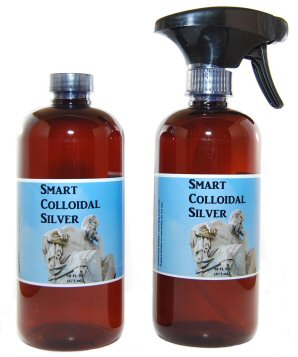Silver is a natural antimicrobial which kills bacteria, viruses, fungi/yeasts, molds and protozoa parasites
Water Well Disinfecting With Smart Colloidal Silver
Printer friendly pdf format
22-minute video
Disclaimers:
· The EPA has
established a 50 ppb MCL (parts per billion Maximum Contaminate
Level) limit on silver in drinking water. If tap water test results
exceed this amount, we must recommend that a reverse osmosis filter
be used for drinking water.
· The author accepts
no liability for damages from accidents or water contamination. Do
your own research and follow these instructions at your own risk.
Water testing is part of the process for your safety.
Caution: Use extreme
caution
when working with electricity and water. Together, water and
electricity can be deadly.
Wells should be
disinfected:
1. When the
well is newly drilled
2. When
repairs to the well or pumping equipment are completed
3. When an
unsafe sample has been reported
4. At least twice per year to prevent contamination
Important:
1.
Silver
is a natural anti-microbial
which kills bacteria, viruses, fungi/yeasts, molds and protozoa
parasites.
2.
Silver ions will
quickly react with surfaces in the well and piping,
thereby losing their ability to kill microbes.
DO NOT USE CLEAR SILVER ION
(ionic silver) PRODUCTS.
3.
Silver
nanoparticles suspended and encapsulated in protein are less able to
contact and kill microbes.
Also, protein can feed
microbes and possibly result in more well contamination.
DO NOT USE SILVER PROTEIN
PRODUCTS.
4.
Smart Colloidal Silver
(minimum 30ppm silver) is real colloidal silver containing
predominantly silver nanoparticles suspended by mutual repulsion in
very pure steam distilled water, with some silver ions also
dissolved in the water. Silver nanoparticles will persist and keep
killing microbes. Visit
http://smartcolloidal.com/RealColloidalSilver.html
to learn more about real colloidal silver and how to distinguish
it from the very large majority of products masquerading as
“colloidal silver”.
Benefits of Disinfecting with Smart Colloidal Silver, instead of 5.25% chlorine bleach.
1. Smart Colloidal Silver is all-natural.
2. Silver is often used to purify water for safe drinking.
3. Silver won’t damage well wiring, pump or casing.
4. No danger from skin contact.
5. No danger from harmful chlorine gases.
6. The well area is safe for animals and children during disinfecting.
7. No need to dilute in 5-gallons of water, making it much simpler to put in the well.
8. Unlike chlorine bleach, silver nanoparticles don’t react with surfaces and
will continue to kill microbes so long as they can contact them.
9. Its not necessary to flush Smart Colloidal Silver from the well
and piping
before the whole house carbon filter and/or reverse osmosis filter
10.No need to test for chlorine residue.
If a very small proportion of the silver gets through a
poorly maintained whole house carbon filter or reverse osmosis
filter, the EPA has established a 50 parts per billion MCL (Maximum
Contaminate Level) limit on silver in drinking water.
11.Silver nanoparticles will accumulate in the well for more effectiveness
with additional treatments, unlike bleach.
12.Less scale in the well and pipes will be loosened to block filters and
plumbing.
13.Its not necessary to replace any water filters after disinfecting.
14.Silver nanoparticles will not consume part of your activated carbon filter
life like
chlorine does
15.Hydrogen sulfide (H2S) gas in sulfur water does not neutralize the
antimicrobial action of silver, unlike chlorine.
H2S reacting with silver nanoparticles tarnishes the outside
of them with a silver sulfide (Ag2S) coating which is still an
antimicrobial which will keep on killing.
16.If you have sulfur water, it’s not necessary to double the amount
as recommended with bleach
which increases the risk of chlorine residue in your drinking
water.
17.Filters do not need to be removed or bypassed
during treatment, except for the carbon and reverse osmosis filters
as instructed.
18.The silver nanoparticles captured in filters will add an antimicrobial
effect
when water passes through. This should increase after more
treatments through the same filter.
19.Will not damage appliances and water treatment devices
(water softeners, reverse osmosis systems, etc.) allowing them to be
disinfected at the same time.
20.Will not harm landscaping, or any bodies of water.
21.Use at least the same amount of Smart Colloidal Silver 30ppm
as you would of laundry bleach for your well’s diameter and water
depth (above the well bottom)
according to the following table from Minnesota Department of
Health. More is always better
with Smart Colloidal Silver, but not with bleach.
|
Amount of water in well (feet) |
Well Casing Diameter (inches) |
||
|
|
2 |
4 |
6 |
|
10 |
2 cups |
2 cups |
2 cups |
|
50 |
2 cups |
2 cups |
3 cups |
|
100 |
2 cups |
3 cups |
1 quart |
|
300 |
3 cups |
1 quart |
2.5 quarts |
If you don’t know your well water depth, contact your state health department for
your well’s drilling record
You should double the disinfectant amount in the table above if:
·
The well has not been disinfected in over 6-months
· It’s the first time to disinfect with Smart Colloidal Silver
(guaranteed 30ppm minimum)
· The water system contains more buildings,
· Has large amounts of pipes or storage, or
· If you’re disinfecting because your well was flooded, has nuisance
bacteria, or is a dug well.
· Using a brand of
real
colloidal silver with less than 30ppm guaranteed or
less yellow (lighter yellow or more amber to brown indicating
larger, less effective nanoparticles).
o
If another product used is much weaker, more than
doubling the amount may be necessary.
Silver protein products are much less effective, could feed microbes and should not be used.
Well Disinfecting Process
Please read the entire
process before beginning to assure you have all the needed items.
If you will also be disinfecting the pipes, fixtures and appliances
(step 10 below), its best to treat just
before everyone leaves for at least a day.
1.
If needed, from the nearest hydrant, pump the well enough in advance
to completely remove sediment and debris caused by construction or
repairs.
2. Close a valve on the other side of the pressure tank from the well.
3. Extend a garden hose from the well to an outside hydrant before the
pressure tank and connect it to the hydrant.
4. Open an access port to inside the well. The process will go much
faster if the port has a hose connection thread attached or is large
enough to insert the hose end. If the latter, a spray nozzle fitting
in the wide-open position may be inserted through a smaller port.
-
If well has no access port, contact a qualified well service technician to safely add one per applicable codes. Caution: drilling into a well may damage electrical wire insulation and cause a short circuit.
-
Caution: If well pump wiring will be exposed during the process, Turn OFF the electrical power to the pump. If the circuit breaker box has a lockout hasp, use it to prevent the breaker from being accidentally turned ON.
5. Open the Smart Colloidal Silver push/pull cap by pulling it. If any
will remain in the bottle, don’t remove the cap to help avoid
contamination possibly entering the bottle.
6. Squeeze out the desired amount into the well port. If any will
remain in the bottle, be careful not to allow any contamination to
be sucked into the bottle when allowing it to expand between
squeezes. Note: a 20-ounce bottle contains 2-1/2 cups.
7. Connect the hose to the well access port or insert the hose through
the port.
8. Open the hydrant and allow water to circulate in the well. Continue
at least until 100-gallons per cup in the table above has circulated
or at least 15 minutes. If you don’t know your flow rate, see how
long it takes to fill a 5-gallon bucket and multiply that number of
minutes by 20 times the number of cups.
-
Caution: If well power was turned off, before restoring power, inspect all exposed electrical wiring for insulation cracking, peeling, or missing wire nuts. Be careful, the wires in the well casing are “live and hot.”
9.Remove the hose, close the well port and open the valve after the
pressure tank.
-
Caution: If electrical wiring is exposed, first repeat step 4b before performing this step, then after completing this step repeat step 8a.
10. Let the water stand in the well for at least 24-hours, if possible, but no less than 2-hours.
11.If you also want to disinfect the piping and fixtures and avoid
consuming silver nanoparticles:
-
Notify everyone that might use water of the treatment being conducted and the unavailability of water during that time. It’s best to post signs or disable faucets and fixtures to prevent anyone from using the water.
-
Bypass whole house carbon filters and reverse osmosis filters
-
To disinfect all the way to the water outlets, carbon and RO filters at fixtures and appliances will also need to be bypassed.
-
Run at least the hot water tank’s volume water through it by opening all the hot water fixtures to be disinfected in the same step.
-
Run cold water through each fixture for as long as it takes to get water from the pressure tank to the outlet.
-
Close all fixtures.
-
Restore the ability of water to flow through the carbon and/or reverse osmosis filter.
-
Close the main water valve after the pressure tank and let the water stand in the well, pipes and fixtures for at least 24-hours, if possible, but no less than 2-hours.
-
Restore flow through carbon and RO filters at fixtures and appliances which were bypassed
-
Open the main water valve after the pressure tank
-
Flush the hot water tank through a hose to a drain.
-
Again, run hot and cold water through each fixture for as long as it takes to get water from the pressure tank to the fixture.
-
If the drains go to a septic system, use a septic tank treatment to assure the silver doesn’t diminish the biological activity.
12.
Sample the well water as you normally would for biological
contamination.
-
If you might have had contamination, sample after waiting the full 24-hours and test before using. Otherwise, sample after 2 to 4 weeks, allowing for any possible bacterial regrowth.
-
Label sample bottles with the location, date, time and name of person collecting the sample. If there was an earlier positive test showing contamination, also write RETAKE on the bottle.
-
Do not use an empty bottle of Smart Colloidal Silver for the sample to avoid killing microbes in the sample, resulting in an incorrect test. Rinsing the bottle may not adequately remove some residual silver on the inner wall of the bottle.
13.
If you have a septic system, after a couple of weeks put some biological septic treatment down a toilet to help assure continued proper function.
Repeat this disinfecting process every 6-months or more often as necessary to maintain safe drinking water based on tests for biological contamination.


